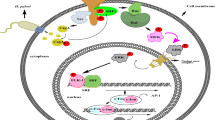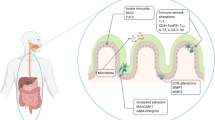Abstract
Purpose
To investigate the association between Helicobacter pylori infection and its inflammatory reaction in gastritis, gastric ulcer, and gastric cancer, a new tumor necrosis factor-α (TNF-α)-inducing protein of H. pylori was studied.
Methods
The HP0596 gene of H. pylori was identified as the TNF-α-inducing protein (Tipα) gene from genome sequence of H. pylori strain 26695. Using recombinant Tipα (rTipα) and deleted Tipα (rdel-Tipα) proteins, the latter of which lacks six amino acids containing two cysteines in the N-terminal domain, we examined their activities in TNF-α gene expression and NF-κB activation in both Bhas 42 (v-H-ras transfected BALB/3T3) cells and mouse gastric epithelial cell line MGT-40, and in vitro transformation of Bhas 42 cells.
Results
Tipα protein as a homodimer form (38 kDa) was found in both extracts and culture medium of various H. pylori strains. rTipα significantly induced TNF-α gene expression and NF-κB activation in both Bhas 42 cells and MGT-40, and induced in vitro transformation of Bhas 42 cells. However, rdel-Tipα did not. Treatment with MG-132, a proteasome inhibitor, inhibited translocation of NF-κB p65, and abrogated TNF-α induction induced by Tipα protein.
Conclusion
Tipα is a new carcinogenic factor released from H. pylori mediated through NF-κB activation.





Similar content being viewed by others
References
Alm RA, Ling L-S, Moir DT, King BL, Brown ED, Doig PC, Smith DR, Noonan B, Guild BC, deJonge BL, Carmel G, Tummino PJ, Caruso A, Uria-Nickelsen M, Mills DM, Ives C, Gibson R, Merberg D, Mills SD, Jiang Q, Taylor DE, Vovis GF, Trust TJ (1999) Genomic-sequence comparison of two unrelated isolates of the human gastric pathogen Helicobacter pylori. Nature 397:176–180
Asaka M, Kato M, Sugiyama T, Satoh K, Kuwayama H, Fukuda Y, Fujioka T, Takemoto T, Kimura K, Shimoyama T, Shimizu K, Kobayashi S (2003) Japan Helicobacter pylori Eradication Study Group. Follow-up survey of a large-sclae multicenter, double-blind study of triple therapy with lansoprazole, amoxicillin, and clarithromycin for eradication of Helicobacter pylori in Japanese peptic ulcer patients. J Gastroenterol 38:339–347
Atherton JC, Cao P, Peek RM Jr, Tummuru MKR, Blaser MJ, Cover TL (1995) Mosaicism in vacuolating cytotoxin alleles of Helicobacter pylori. J Biol Chem 270:17771–17777
Correa P (2003) Helicobacter pylori infection and gastric cancer. Cancer Epidemiol Biomarkers Prev 12:238s–241s
Fujiki H, Suganuma M, Okabe S, Kurusu M, Imai K, Nakachi K (2002) Involvement of TNF-α changes in human cancer development, prevention and palliative care. Mech Ageing Dev 123:1655–1663
Fujiki H, Takeuchi H, Nishitani N, Yamanaka H, Suzuki K, Kurusu M, Suganuma M (2004) Carcinogenic potential of tabacco tar-resistant Staphylococcus aureus in buccal cavity. J Cancer Res Clin Oncol 130:301–305
Gobert AP, Bambou J-C, Werts C, Balloy V, Chignard M, Moran AP, Ferrero RL (2004) Helicobacter pylori heat shock protein 60 mediates interleukin-6 production by macrophages via a toll-like receptor (TLR)-2-, TLR-4-, and myeloid differentiation factor 88-independent mechanism. J Biol Chem 279:245–250
IARC Working Group on the Evaluation of Carcinogenic Risks to Humans (1994) In: IARC Monographs on the evaluation of carcinogenic risks to humans, vol 61. Schistosomes, liver flukes and Helicobacter pylori. IARC, Lyon , pp 177–240
Ichinose M, Nakanishi H, Fujino S, Tatematsu M (1998) Establishment and characterization of two cell lines from N-methyl-N-nitrosourea-induced mouse glandular stomach carcinomas. Jpn J Cancer Res 89:516–524
Karin M, Cao Y, Grete FR, Li Z-W (2002) NF-κB in cancer: from innocent bystander to major culprit. Nature Rev Cancer 2:301–310
Ley C, Mohar A, Guarner J, Herrera-Goepfert R, Figueroa LS, Halperin D, Johnstone I, Parsonnet J (2004) Helicobacter pylori eradication and gastric preneoplastic conditions: a randomized, double-blind, placebo-controlled trial. Cancer Epidemiol Biomarkers Prev 13:4-10
Montemurro P, Barbuti G, Dundon WG, Del Giudice G, Rappuoli R, Colucci M, De Rinaldis P, Montecucco C, Semeraro N, Papini E (2001) Helicobacter pylori neutrophil-activating protein stimulates tissue factor and plasminogen activator inhibitor-2 production by human blood mononuclear cells. J Infect Dis 183:1055–1062
Moore RJ, Owens DM, Stamp G, Arnott C, Burke F, East N, Holdsworth H, Turner L, Rollins B, Pasparakis M, Kollias G, Balkwill F (1999) Mice deficient in tumor necrosis factor- α are resistant to skin carcinogenesis. Nature Med 5:828–831
Normark S, Nilsson C, Normark BH, Hornef MW (2003) Persistent infection with Helicobacter pylori and the development of gastric cancer. Adv Cancer Res 90:63–89
Odenbreit S, Puls J, Sedlmaier B, Gerland E, Fischer W, Haas R (2000) Translocation of Helicobacter pylori cagA into gastric epithelial cells by type IV secretion. Scinece 287:1497–1500
Ohmori K, Sasaki K, Asada S, Tanaka N, Umeda M (2004) An assay method for the prediction of tumor promoting potential of chemicals by use of Bhas 42 cells. Mutat Res 552:191–202
Palombella VJ, Rando OJ, Goldberg AL, Maniatis T (1994) The ubiquitin-proteasome pathway is required for processing the NF-κB1 precursor protein and the activation of NF-κB. Cell 78:773–785
Peek RM Jr, Blaser MJ (2002) Helicobacter pylori and gastrointestinal tract adenocarcinomas. Nature Rev Cancer 2:28–37
Perez AL, Kato M, Nakagawa S, Kawarasaki M, Nagasako T, Mizushima T, Oda H, Kodaira J, Shimizu Y, Komatsu Y, Zheng R, Takeda H, Sugiyama T, Asaka M (2002) The relationship between consumption of antimicrobial agents and the prevalence of primary Helicobacter pylori resistance. Helicobacter 7:306–309
Sasaki K, Mizusawa H, Ishidate M, Tanaka N (1990) Transformation of RAS transfected BALB 3T3 clone (Bhas 42) by promoters: application for screening and specificity of promoters. Toxicol In Vitro 4:657–659
Shimizu N, Inada K, Nakanishi H, Tsukamoto T, Ikehara Y, Kaminishi M, Kuramoto S, Sugiyama A, Katsuyama T, Tatematsu M (1999) Helicobacter pylori infection enhances glandular stomach carcinogenesis in Mongolian gerbils treated with chemical carcinogens. Carcinogenesis 20:669–676
Shimoyama T, Fukuda S, Tanaka M, Mikami T, Saito Y, Munakata A (1997) High prevalence of the CagA-positive Helicobacter pylori strains in Japanese asymptomatic patients and gastric cancer patients. Scand J Gastroenterol 32:465–468
Sueoka E, Sueoka N, Okabe S, Komori A, Suganuma M, Kozu T, Fujiki H (1998) Tumorigenicity of MTG8, a leukemia-related gene, in concert with v-Ha-ras gene in BALB/3T3 cells. Br J Haematol 101:737–742
Sueoka E, Goto Y, Sueoka N, Kai Y, Kozu T, Fujiki H (1999) Heterogeneou nuclear ribonucleoprotein B1 as a new marker of early detection for human lung cancers. Cancer Res 59:1404–1407
Suganuma M, Okabe S, Marino MW, Sakai A, Sueoka E, Fujiki H (1999) Essential role of tumor necrosis factor α (TNF-α) in tumor promotion as revealed by TNF-α -deficient mice. Cancer Res 59:4516–4518
Suganuma M, Kurusu M, Okabe S, Sueoka N, Yoshida M, Wakatsuki Y, Fujiki H (2001) Helicobacter pylori membrane protein 1: a new carcinogenic factor of Helicobacter pylori. Cancer Res 61:6356–6359
Suganuma M, Okabe S, Kurusu M, Iida N, Ohshima S, Saeki Y, Kishimoto T, Fujiki H (2002) Discrete roles of cytokines, TNF-α, IL-1, IL-6 in tumor promotion and cell transformation. Int J Oncol 20:131–136
Sugiyama A, Maruta F, Ikeno T, Ishida K, Kawasaki S, Katsuyama T, Shimizu N, Tatematsu M (1998) Helicobacter pylori infection enhances N-methyl-N-nitrosourea-induced stomach carcinogenesis in the Mongolian gerbil. Cancer Res 58:2067–2069
Sumie A, Yamashiro T, Nakashima K, Nasu M, Watanabe M, Nishizono A (2001) Comparison of genomic structures and antigenic reactivities of orthologous 29-kilodalton outer membrane proteins of Helicobacter pylori. Infect Immun 69:6846–6852
Takada Y, Khuri FR, Aggawal B (2004) Protein farnesyltransferase inhibitor (SCH 66336) abolishes NF-κB activation induced by various carcinogens and inflammatory stimuli leading to suppression of NF-κB-regulated gene expression and up-regulation of apoptosis. J Biol Chem 279:26287–26299
Tomb J-F, White O, Kerlavage AR, Clayton RA, Sutton GG, Fleischmann RD, Ketchum KA, Klenk HP, Gill S, Dougherty BA, Nelson K, Quackenbush J, Zhou L, Kirkness EF, Peterson S, Loftus B, Richardson D, Dodson R, Khalak HG, Glodek A, McKenney K, Fitzegerald LM, Lee N, Adams MD, Hickey EK, Berg DE, Gocayne JD, Utterback TR, Peterson JD, Kelley JM, Cotton MD, Weidman JM, Fujii C, Bowman C, Watthey L, Wallin E, Hayes WS, Borodovsky M, Karp PD, Smith HO, Fraser CM, Venter JC (1997) The complete genome sequence of the gastric pathogen Helicobacter pylori. Nature 388:539–547
Tsuchihara K, Hijikata M, Fukuda K, Kuroki T, Yamamoto N, Shimotohno K (1999) Hepatitis C virus core protein regulates cell growth and signal transduction pathway transmitting growth stimuli. Viology 258:100–107
Uemura N, Mukai T, Okamoto S, Yamaguchi S, Mashiba H, Taniyama K, Sasaki N, Haruma K, Sumii K, Kajiyama G (1997) Effect of Helicobacter pylori eradication on subsequent development of cancer after endoscopic resection of early gastric cancer. Cancer Epidemiol. Biomarkers Prev 6:639–642
Yoshida M, Wakatsuki Y, Kobayashi Y, Itoh T, Murakami K, Mizoguchi A, Usui T, Chiba T, Kita T (1999) Cloning and characterization of a novel membrane-associated antigenic protein of Helicobacter pylori. Infect Immun 67:286–293
Zivny J, Wang TC, Yantiss R, Kim KH, Houghton J (2003) Role of therapy or monitoring in preventing progression to gastric cancer. J Clin Gastroenterol 36 [Suppl 5]:S50–S60
Acknowledgements
Supported by the following Grants-in-Aid: Scientific Research on Priority Areas for Cancer Research from the Ministry of Education, Culture, Sports, Science and Technology, Japan, and the Smoking Research Fund. We thank Ms Ikuko Shiotani, Saitama Cancer Center, for her assistance and Ms Maki Kimoto, Oita Medical University, for technical assistance in bacterial cultures. We also thank Drs Masae Tatematsu and Chihiro Sasakawa for the supply of MGT-40 cells and H. pylori strain 26695 and 26695ΔcagPΑΙ.
Author information
Authors and Affiliations
Corresponding author
Rights and permissions
About this article
Cite this article
Suganuma, M., Kurusu, M., Suzuki, K. et al. New tumor necrosis factor-α-inducing protein released from Helicobacter pylori for gastric cancer progression. J Cancer Res Clin Oncol 131, 305–313 (2005). https://doi.org/10.1007/s00432-004-0652-x
Received:
Accepted:
Published:
Issue Date:
DOI: https://doi.org/10.1007/s00432-004-0652-x




